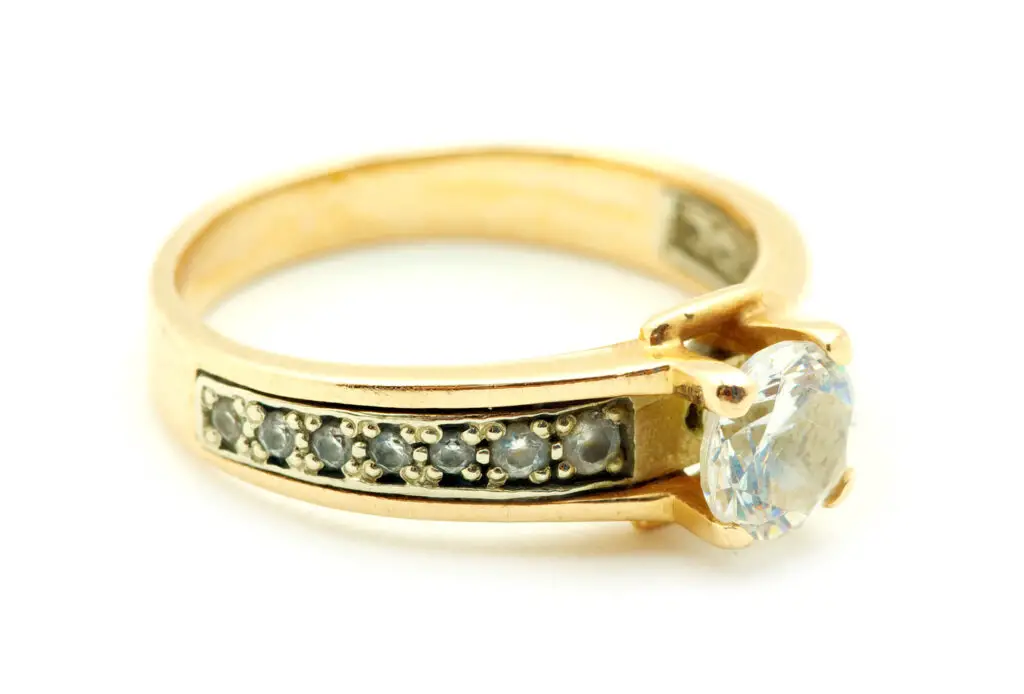Gold, with its lustrous sheen and timeless allure, has captivated humanity for millennia. Its beauty, rarity, and resistance to tarnishing make it a highly sought-after material for jewelry and investments. Yet, have you ever wondered why your precious gold pieces sometimes lose their shine and turn black? In today’s blog post, we’ll unravel the mystery behind this seemingly inexplicable phenomenon and provide some easy cleaning methods to restore your gold to its former glory.
We’ll explore the various reasons why gold can turn black, including external factors such as skin chemistry and exposure to certain elements, as well as the composition of the gold itself. By understanding the causes, you’ll be better equipped to prevent and address the problem. Plus, we’ll share some simple and effective cleaning solutions, so you can continue to enjoy the brilliance and elegance of your gold treasures for years to come. Let’s dive in and uncover the secrets behind gold’s transformation!

Reasons Why Gold Turns Black
Burning
While pure gold is incredibly stable and resistant to tarnishing, it is also a relatively soft metal. To make it more durable and suitable for use in jewelry, it is often alloyed with other metals like copper, silver, or nickel. The presence of these additional metals in the alloy can make gold more susceptible to discoloration when exposed to heat or flame.
When gold is heated or burned, the alloyed metals can react with oxygen to form oxides. These oxides are responsible for the black or darkened appearance of the gold after being exposed to fire. In the case of gold jewellery, the most common alloying metals are copper and silver, both of which can form dark oxides when heated.
Copper, for instance, reacts with oxygen to form copper oxide, which has a dark or black appearance. Similarly, silver forms silver oxide when exposed to oxygen and heat, which can also have a dark hue. When these oxides form on the surface of your gold jewellery, they can give it a black or tarnished appearance.
It’s important to note that pure gold (24 karats) is unlikely to turn black from burning because it does not contain any other metals that would react with oxygen. However, most gold jewelry is made from lower-karat gold (e.g., 14 or 18 karats), which contains a higher percentage of alloying metals and is more susceptible to discoloration when exposed to heat.
To avoid discoloration or damage to your gold jewellery, it’s best to keep it away from heat sources, open flames, and high-temperature environments.
Surface Corrosion
Surface corrosion is another reason gold can turn black, despite its reputation for being tarnish-resistant. While pure gold (24 karats) is chemically inert and does not corrode, gold alloys containing other metals can be susceptible to this issue. Typically, lower-karat gold (e.g., 10, 14, or 18 karats) is more prone to surface corrosion due to the presence of these additional metals.
Corrosion occurs when a metal reacts with substances in its environment, leading to the formation of new compounds on its surface. In the case of gold, it is the alloying metals that usually react with certain substances, resulting in a dark or black layer on the gold’s surface. Some common causes of surface corrosion in gold include:
Exposure to chemicals: Gold alloys can react with various chemicals, such as chlorine, sulfur, and even some cleaning agents. Prolonged exposure to these substances can cause the alloying metals to corrode, creating a darkened surface layer.
Contact with skin: Some people have skin chemistry that may cause gold alloys to corrode over time. Acids, oils, and salts found in sweat and skin can react with the alloying metals, leading to corrosion and discoloration.
Environmental factors: Exposure to humid or polluted environments can also contribute to surface corrosion in gold alloys. Airborne pollutants, such as sulfur dioxide, can react with the alloying metals, promoting the formation of dark surface layers.
To prevent surface corrosion and keep your gold jewellery looking its best, it’s essential to take proper care of your pieces. This includes storing them in a dry, cool place, removing them before swimming or using cleaning products, and cleaning them regularly with a gentle, non-abrasive cleaner. If your gold has turned black due to surface corrosion, you can usually restore its shine by using an appropriate cleaning method or seeking professional help from a jeweller.
Low Quality Plating
Gold-plated jewelry is a popular and more affordable alternative to solid gold pieces. It involves applying a thin layer of gold over another metal, typically a base metal such as brass, copper, or silver. However, low-quality plating can lead to the gold layer wearing off or turning black, diminishing the jewellery’s appearance.
Here are some reasons why low-quality plating can cause gold to turn black:
Inadequate thickness: A thinner layer of gold is more susceptible to wear and tear. As the gold layer wears away, the base metal beneath is exposed. Over time, the exposed base metal can oxidize or react with substances in the environment, leading to a darkened or black appearance on the gold-plated surface.
Inferior base metal: The quality of the base metal plays a significant role in the longevity of gold-plated jewelry. If the underlying metal is prone to tarnishing or corrosion, it can cause the gold layer to darken or turn black. For example, if the base metal contains high levels of copper, it can oxidize and darken over time, affecting the appearance of the gold plating.
Poor adhesion: If the gold layer is not properly adhered to the base metal, it can lead to uneven wearing or peeling of the gold layer.
Metal Abrasion
Another reason gold can turn black is metal abrasion, a process that occurs when the gold surface rubs against other objects or surfaces, causing tiny particles to wear away. While gold is a relatively soft metal, it is still susceptible to abrasion, especially when alloyed with other metals or used in everyday jewelry pieces. Here’s how metal abrasion can contribute to gold turning black:
Gold alloys: Gold jewelry is often made with alloys containing other metals, such as copper, silver, or nickel, to improve its strength and durability. However, these alloying metals can be more prone to tarnishing and corrosion. When the gold surface wears away due to abrasion, the darker underlying metals can become exposed, giving the piece a darkened or black appearance.
Rhodium plating: Some gold jewelry, particularly white gold, is plated with rhodium to enhance its shine and protect it from tarnishing. Over time, the rhodium plating can wear off due to abrasion, exposing the underlying gold alloy. If the alloy contains metals that are prone to tarnishing or oxidation, it can lead to the jewelry appearing black or discolored.
Contact with harder materials: Gold’s softness makes it vulnerable to scratches and abrasions when it comes into contact with harder materials, such as gemstones or other metal surfaces. Continuous contact and friction can cause the gold layer to wear away, revealing darker metals underneath and resulting in a blackened appearance.
To minimize the risk of metal abrasion, it’s essential to take proper care of your gold jewellery. This includes removing your jewellery during activities that may cause scratching or rubbing, storing pieces separately to avoid contact with harder materials, and cleaning them regularly with a soft, non-abrasive cloth. If your gold has turned black due to metal abrasion, a professional jeweller can often restore its appearance by polishing the surface or applying a new layer of gold or rhodium plating, if necessary.
Different Types Of Gold Turn Black More Than Others
Gold jewelry comes in various forms, including pure gold, gold alloys, and gold plating. The likelihood of gold turning black depends on the type and composition of the gold used in the piece. Here’s a closer look at how different types of gold can be more susceptible to blackening than others:
Pure gold (24 karats): Pure gold is chemically inert and does not tarnish or corrode, making it the least likely to turn black. However, it is also quite soft and not commonly used in everyday jewelry pieces due to its malleability.
Gold alloys (10, 14, or 18 karats): Gold alloys are created by mixing gold with other metals, such as copper, silver, or nickel, to improve its strength and durability. The presence of these alloying metals increases the likelihood of gold turning black, as they can tarnish, oxidize, or corrode when exposed to various environmental factors or chemicals. Lower-karat gold (e.g., 10 or 14 karats) has a higher percentage of alloying metals, making it more susceptible to blackening than higher-karat gold (e.g., 18 karats).
Gold plating: Gold-plated jewelry consists of a base metal coated with a thin layer of gold. The quality and thickness of the gold layer, as well as the type of base metal used, can impact the likelihood of the gold turning black. Low-quality plating or a base metal prone to tarnishing or corrosion can lead to a darkened or black appearance as the gold layer wears off.
White gold: White gold is an alloy made by combining gold with metals like palladium, nickel, or silver, giving it a silvery-white color. It is often plated with rhodium for added shine and protection against tarnishing. Over time, the rhodium plating can wear off, exposing the gold alloy underneath, which may contain metals prone to oxidation or tarnishing, causing the piece to appear blackened.
To minimize the risk of gold turning black, it’s essential to understand the specific type of gold used in your jewellery pieces and take appropriate care measures. This may include avoiding exposure to chemicals, taking off your jewellery during activities that could cause abrasion, and cleaning your pieces regularly with a soft cloth and gentle cleaner. If your gold has turned black, a professional jeweller can often restore its appearance through polishing or re-plating.
Why Does Gold Turn My Skin Black?
When gold turns your skin black, it is usually due to a chemical reaction between the metals in the gold alloy and substances on your skin or in the environment. Here are a few reasons why this may occur:
Metal alloys: Gold used in jewelry is often mixed with other metals, such as copper, silver, or nickel, to increase its strength and durability. These alloying metals can react with certain substances on your skin or in the environment, causing a dark residue to form, which can then transfer onto your skin.
Skin chemistry: The natural oils, sweat, and acidity levels of your skin can cause a chemical reaction with the metals in gold jewelry. This reaction can create dark compounds that can rub off onto your skin, leaving a black or greenish-black mark. Some people have a higher skin acidity level, which can make them more prone to this reaction.
Cosmetics and lotions: Makeup, lotions, and other skincare products can also react with the metals in gold jewelry, leading to the formation of dark compounds that can rub off onto your skin.
Environmental factors: Airborne pollutants, such as sulfur compounds, can react with the metals in gold jewelry, causing the formation of dark residues that can transfer onto your skin.
To minimize the risk of gold jewellery turning your skin black, you can take the following precautions:
Keep your skin and jewelry clean: Regularly clean your jewelry with a soft cloth and gentle cleaner, and ensure your skin is clean and dry before wearing gold jewelry.
Apply a barrier: Consider applying a thin layer of clear nail polish or jewelry coating to the part of the jewelry that comes in contact with your skin. This can help create a barrier between the metal and your skin, reducing the likelihood of a reaction.
Opt for higher-karat gold: Higher-karat gold (e.g., 18 or 22 karats) contains a higher percentage of gold and fewer alloying metals, making it less likely to react with your skin. However, it is also softer and may be less suitable for everyday wear.
Avoid wearing jewellery in wet or humid conditions: Moisture can accelerate the chemical reactions that cause gold to turn your skin black, so remove your jewellery before swimming, showering, or exercising.
If you continue to experience issues with gold turning your skin black, you may want to consult a professional jeweller or dermatologist for further advice.
Easy Ways To Clean Gold That Has Turned Black
An easy and natural way to clean gold jewellery that has turned black without causing any damage is to use a gentle homemade solution made from common household items. Baking soda and water create a mild cleaning solution that can help remove tarnish and restore your gold jewellery’s shine.
Here’s a step-by-step guide to cleaning your gold jewelry using baking soda and water:
Prepare the cleaning solution: In a small bowl, mix a few tablespoons of baking soda with a small amount of water to form a thick paste. The consistency should be similar to toothpaste.
Apply the paste: Using a soft cloth, cotton swab, or your fingers, gently apply the baking soda paste onto the blackened areas of your gold jewelry. Be careful not to scratch the surface, especially if your jewelry contains gemstones.
Gently scrub: With a soft-bristled toothbrush, gently scrub the blackened areas to remove the tarnish. Use light pressure and circular motions to avoid causing scratches. Be particularly gentle with delicate designs and settings.
Rinse: Once you’ve finished scrubbing, rinse the jewelry thoroughly under lukewarm water to remove any residue of the baking soda paste. Make sure to use a sink stopper or a mesh strainer to prevent the jewelry from accidentally falling down the drain.
Dry and polish: Carefully dry your gold jewelry with a soft, lint-free cloth. Once dry, use a clean, soft cloth to buff and polish the gold, restoring its shine.

